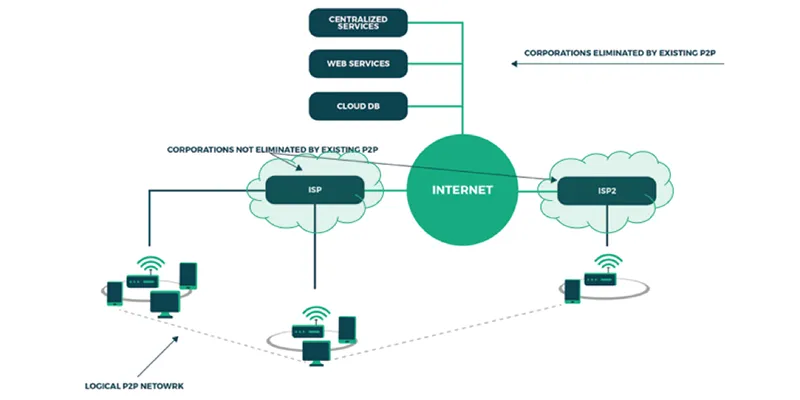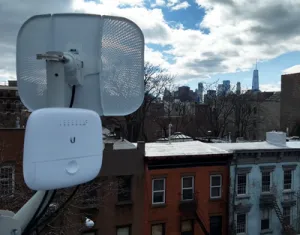
RightMesh
View Brand PublisherWhy you should know more about this mobile mesh network that aims to bridge the digital divide
Have you heard this new buzzword in the tech and telecom industries? Mesh networks are promising alternative options for connectivity - ones that don’t necessarily need big, centralised ISPs involved. They are attractive as solutions for last-mile connectivity, to fight the repeal of net neutrality, as an alternative option when central ISPs are taken out by natural disasters, and to circumvent the control of central authorities.
Mesh networking is quite an abstract term, and there are many different forms of mesh networking implementations. Let’s examine a couple of the basic concepts of mesh networking (especially for the non-technical reader) that differentiates them.
What exactly is a mesh network?
A mesh network is a type of network in which the infrastructure is carried by nodes that connect with each other directly and dynamically, and co-operate with one another to efficiently route data packets.
Didn’t quite get that? Well, let’s first understand how traditional internet networks operate today. Let’s assume you want to send an email, and for that you need to have a device — be it a PC, laptop or mobile device — that connects to a network. For the PC or laptop, this usually means connecting to a Wi-Fi access point, or plugging an Ethernet cable into your device. And for the mobile device, this would mean connecting to a local cellular operator or selecting a Wi-Fi network.

From there, your devices are then connected to a central hub or node — which could be a Wi-Fi access point, a network switch, or a cellular base station, and these nodes are connected to other central hubs up in the hierarchy until the email finally reaches the destination, which typically is an email server located in the cloud.
While the advantage of this network lies in its simplicity of adding new devices to the network, this approach can be rather inefficient for a number of cases. Assume that a professor is emailing a document to her classroom of 100 students. That document needs to go up through a long path of multiple network hubs until it reaches the email server, and then is pulled down again separately by each student, for a total of 100 downloads of the same file. And in this scenario, every student requires a dedicated connection to the Wi-Fi access point, without which they cannot get the document.

Mesh networks, on the other hand, involve network ‘nodes’ that can dynamically connect to another nodes, which removes the dependency that one node has on any central hub or provider.
Because each node has the ability to dynamically connect to other nodes, the links between the nodes of a mesh network are typically wireless in nature. The wireless technology used between nodes in a mesh network could be homogeneous (i.e. all nodes using Wi-Fi to connect with neighboring nodes), or heterogeneous (e.g. nodes using either Wi-Fi or Bluetooth or both to connect with neighboring nodes).
Are all mesh networks the same?
Absolutely not! There are different forms of mesh networks to satisfy different needs, objectives and purposes. Generally speaking, mesh networks could be placed somewhere on two scales: fixed versus mobile mesh networks, and closed versus open mesh networks.
Fixed vs. Mobile Mesh Networks
A fixed mesh network is one where the nodes are stationary in position and do not move. The nodes in these networks are more commonly seen as ‘mesh routers’ that operate in Wi-Fi networks (for example the Cisco Meraki routers for commercial deployments or Eero routers for residential deployments) or fixed point-to-point antennas (e.g. the supernodes used for the NYCMesh and guifi.net mesh networks, or the wireless transmitters to be used in Althea mesh networks).

A mobile mesh network, on the other hand, is one where the infrastructure nodes are not stationary and are constantly in motion. Examples of mobile mesh networks include goTenna, Ammbr, and Sonnet Labs.
RightMesh falls under this category as well; however, the primary difference between RightMesh and other mobile mesh networking projects is that most projects usually employ separate wireless devices or antennas to act as the network nodes in a mesh network, and users can then connect their smartphones to those devices. In RightMesh networks, the smartphones themselves act as the network nodes in a mesh network.
It is also important to note that the performance of the mesh network is dependent on the type of mesh network (fixed versus mobile), the capability of the nodes in the network, and the wireless technology used to connect nodes.
Fixed mesh networks that rely on consistent hardware for nodes and use a common wireless link will have a better quality of service than mobile mesh networks with heterogeneous nodes. However, fixed mesh networks come with the cost of deploying and maintaining an infrastructure whereas mobile mesh networks can be spontaneously created anywhere at a very low cost.
Centralised vs. Decentralised Mesh Networks
A centralised (or closed) mesh network is one that operates in a controlled environment and is usually set up by a single organisation for a specific purpose. Because it is in a closed environment, and there needs to be a certain quality of service, these networks are usually implemented as fixed networks with homogeneous wireless links. Examples of these types of networks are Wi-Fi mesh routers that connect different floors of large hotels or office buildings, or residential Wi-Fi mesh routers that are spread across a home to ensure coverage across all areas.
Decentralised (or open) mesh networks on the other hand are crowdsourced mesh networks in which the network is run by a large group of people instead of a single organisation. The work needed to run the network is spread across various users to achieve a cumulative result for everyone in the network. These networks are community driven and can serve as a powerful force to empower people — especially marginalised communities which have difficulties accessing traditional networks because of cost or infrastructure barriers.
RightMesh is a decentralised mobile mesh networking platform because this technology best fits our mission which is deeply rooted in connecting the underserved. Our mission is to connect the next billion users and lift 100 million people out of poverty.
Do we really need mesh networks? Won’t traditional networks connect the entire world eventually?
We believe this is wishful thinking.
It is true that the communication networks that have emerged and evolved over the last several decades have greatly improved life in all sectors, bringing voice, data, and the internet to billions of people all over the world. And this has resulted in new and improved ways for people to interact with each other.
This has also led to a handful of massive corporations accumulating large amounts of profit from these networks over these decades. These corporations, accordingly, are only interested in actions that will lead to even more profits.
The reality is that there are vast areas and communities around the world which are not even close to receiving the benefits that connectivity to the internet provides because there is no incentive for these corporations to serve these areas that equate to low profitability and high operational costs.
This is where mesh networks play an important role. Since they are crowdsourced and are run by the users themselves, networks can be more accessible and affordable for everyone and can potentially help narrow the digital divide that is so prevalent across the world.
Mobile Mesh Networks plus blockchain and cryptocurrency
Mesh networks are vastly different from each other, and RightMesh is now bringing in a whole new differentiator as the world’s first ad-hoc mobile mesh network that integrates blockchain technology and cryptocurrency. As a connectivity solution that was born from the challenges faced by our own employees in Bangladesh, our goal has always been to bring connectivity to the most digitally impoverished nations and regions of the world. Our solution is software-based, requires no additional hardware other than the smartphones already owned by the majority of people in these regions, and actually provides the opportunity for phone owners to become digital entrepreneurs by using their phones as network nodes.
To find out more about RightMesh, visit our website at www.rightmesh.io. To contribute to our Token Generating Event on May 30th, register for KYC/AML.
Rightmesh at a glance:
- Uses participants’ existing smartphones
- Provides internet and cellular connectivity to people in the immediate vicinity
- RMESH tokens are “mined” automatically whenever someone uses the mesh node
- RMESH tokens automatically deposited in unique Ethereum wallet for participant
- Potential market in excess of 2 billion users
- Ideal for India, as more densely-populated areas will be better served by mesh network
- Scales effortlessly
- Token Generating Event – an opportunity to contribute in exchange for RMESH tokens – May 30th, 2018.








